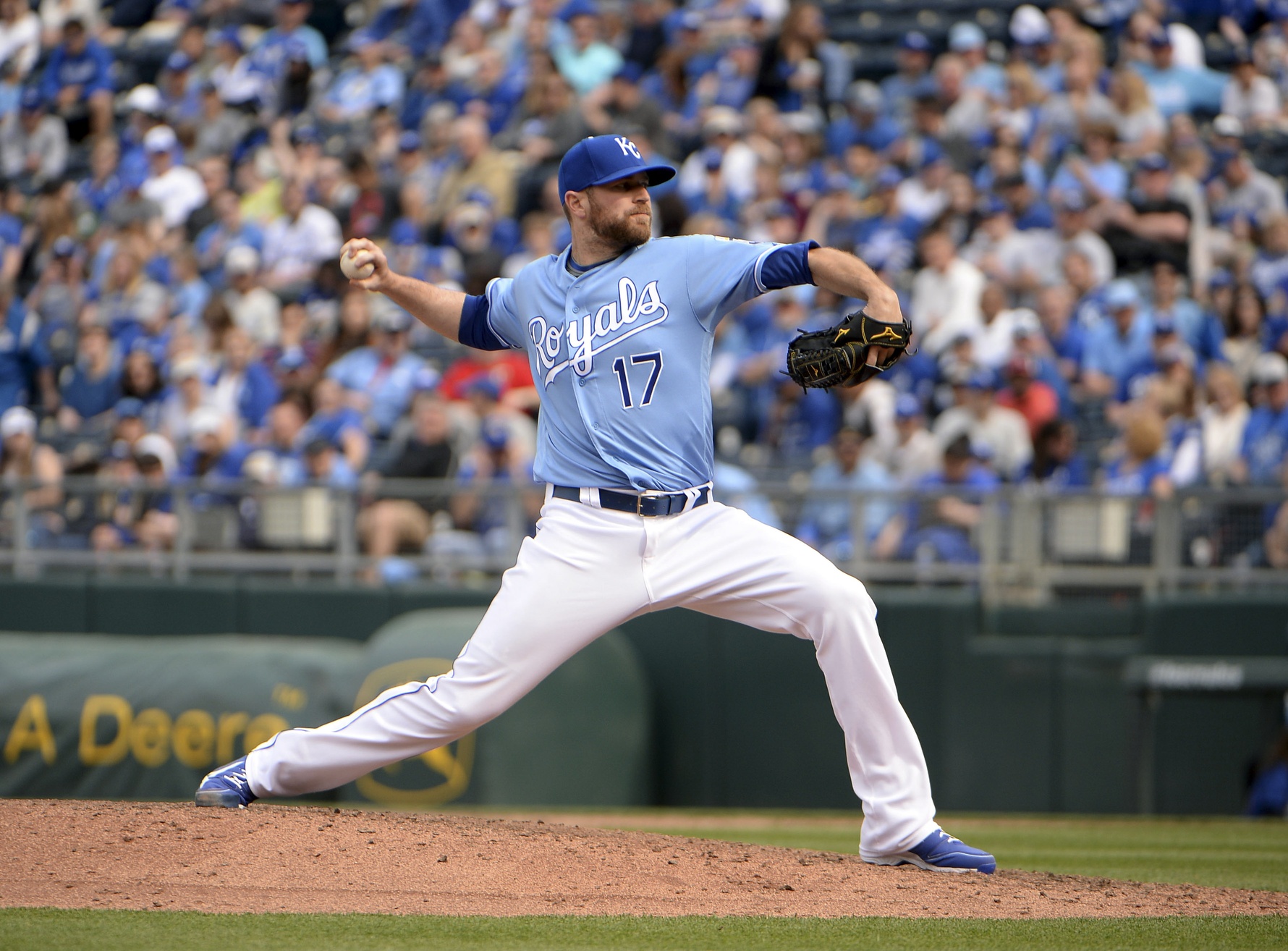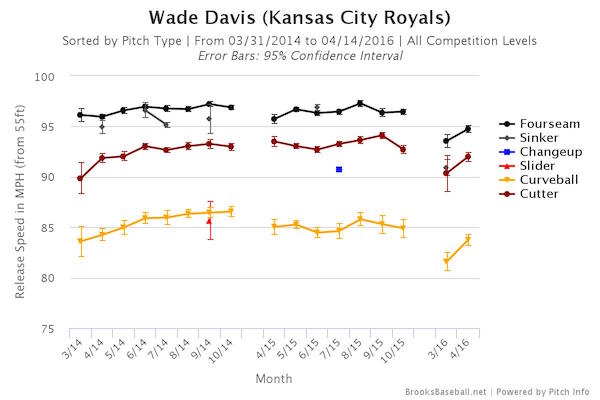The last thing anybody thinks to do when examining the Kansas City Royals is to worry about Wade Davis. Over the last two seasons, he has a 0.97 regular season ERA in 139.1 innings. He’s allowed 71 hits, walked 43 and struck out a whopping 187. So he’s just your run of the mill unhittable reliever who doesn’t walk guys and strikes everybody out. He handles his business with such stoic efficiency that he’s come to be known as a robot or a cyborg. Long story short, Davis hasn’t just been one of the best relievers in baseball; he’s been the best.
This year, Davis has pitched in four games. He has one win and three saves. He hasn’t allowed a run, and he’s allowed just one hit. So far, so good, right? In those four games, he’s pitched four innings, and in those four innings, he’s walked four batters. He’s had to throw 96 pitches total, which is very un-Wade-like. He’s actually getting more swinging strikes than he did last season, but his command just isn’t there. And there’s one other issue – his velocity is down a bit.
So naturally, there’s a little concern. I don’t want to put any ideas out in the universe, but there was a similar concern about Greg Holland at the beginning of 2015. But don’t worry, Holland was actually pretty brilliant in his first four appearances of 2015, throwing four innings with just one week that took 37 pitches to complete. That means these situations are nothing alike. In all seriousness, while there may be some sort of injury, the sheer fact that there’s a sort of similar discussion surrounding Davis as surrounded Holland last year means absolutely nothing.
Davis talked after his shaky performance on Tuesday night and mentioned that his mechanics are a bit out of whack and he’s just working to get them under control. He says it happens every April for him, and it just takes him a little time. Let’s say we take him at his word (robots aren’t programmed to lie, after all). That would make a lot of sense. A mechanical issue would likely lead to some command issues and could very reasonably cause velocity to drop a bit.
Let’s look at that velocity and see just how different it really is. This year, he’s thrown 50 fastballs, according to Brooks Baseball, and his average fastball velocity is 94.75 MPH. Last season, he threw 601 fastballs total and averaged 96.52 MPH. In 2014, he threw 814 fastballs and averaged 96.71 MPH. So on the surface, this looks pretty bad.
But let’s look deeper and look at only his early April velocity, in particular, his first four appearances. Now we’re getting a little closer, but velocity is still down. In 2015, Davis averaged 95.65 MPH on 29 fastballs. In 2014, he averaged 95.86 MPH on 52 fastballs. So the velocity is still down, but just not quite as much as the full season would lead you to believe. It is worth noting that he was pretty bad in his first four outings of 2014, so that’s some cause for belief that Davis goes through this in April sometimes.
At first, I thought maybe Davis didn’t get as much work in spring training to iron out the kinks as he had in the past. When I looked, he did throw less innings in spring of 2016 than in either of the previous two years, but it wasn’t that different. He threw nine innings this year, 10 last year and 11.2 in 2014. I was really hopeful that would be the case because I think that would alleviate a lot of fears over what Davis has done so far this year, but alas, that isn’t the case.
I don’t tell you this to scare you about Davis because I’m honestly not worried about him just yet. Even though the Royals have done a really nice job of not overworking their relievers, these guys have still thrown from March through October in each of the last two seasons. That’s eight months of pitching. Davis has thrown 186 innings in that time. It wouldn’t be all that surprising if Davis actually has lost a little off his fastball and there’s nothing really wrong.
One positive sign is that while he’s averaging 94.25 MPH on his fastball to start the season, he’s topped out at 96.3 MPH in each of his last two outings and averaged 95.2 MPH on 15 fastballs against Houston on Tuesday night. If that number continues to rise, he’ll be back to what we’re used to seeing in no time.
I guess this all kind of piggybacks on my article from the other day about sample sizes and looking for trends through the relatively small amount of noise out there. Yes, Davis has seen a decrease in velocity to start the season. Yes, his command has been far short of what we’re used to seeing from him. But at this point, if he says he’s having a mechanical issue, I think that’s certainly a plausible explanation for all of this.
We’ll keep an eye on this over the next few weeks to see if the velocity jumps up as he gets into the swing of things this season. Personally, if you’re going to worry about anything, I’d worry about the command and not the velocity because when Davis has it working, it’s about the movement and placement of his pitches more than anything else. If he can find his mechanics, he can throw 94 or 97 and get outs at a rate unlike most other pitchers in all of baseball. The guy is so good that he’s looked rough and still has four scoreless innings.
I’m not saying there won’t be a time to worry about Davis, but I am saying that time isn’t now.


I think I’ll file this one under “sometimes there is a deadline and you just have to pump something out.”
The analysis is great, but your own analysis of minimal April sample sizes kind of makes the entire premise of the article a non-starter.
No deadline here. I was curious about the velocity being down, so I decided that I might as well document my curiosity and see what came of it. After his comment about needing to get right mechanically, it made me wonder if he was just saying something to appease fans and media or if that could be a real issue. Based on what I’ve seen from watching the games and what the data tells me, I think it makes a lot of sense. And here we are.
I guess i just get jumpy about early season velo analysis, because many a hack pumps and dumps articles on that very topic every april, only to claim zen-like nostradamus capabilities when they hit on one tommy john out of 50 guys mentioned.
Not saying thats you at all (really like your writing, in fact), but the sample sizes make it basically a dart throwing exercise at this point.
That really was kind of my point. The perception that he’s not throwing as hard is real, but because early season readings for relievers can be so finicky, it’s not a concern at this point. I probably would have left it alone if he had his usual command and efficiency, but with struggles there, it made me want to just take a closer look.
“Last season, he threw 601 fastballs total and averaged 96.52 MPH”
I do not agree http://www.nydailynews.com/blogs/baseballinsider/self-awareness-new-market-inefficiency-kansas-city-royals-won-james-shields-trade-ike-davis-move-blog-entry-1.1977398